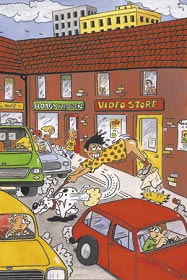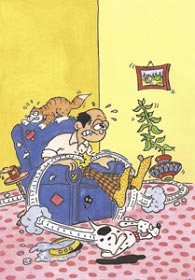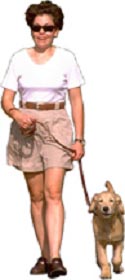Why
do dogs tend to pull, chase
and forge ahead?
Dogs
tend to pull ahead and lunge
forward for a number of reasons.
The primary reason for most
dogs (at least initially) is
that they are exploratory, playful
and social, and they are motivated
to investigate new areas, new
odors and new people or new
dogs as well as areas where
exciting things have been found
in the past.  The
more they pull, the faster they
get where they are going. As
you pull backwards in an attempt
to restrain your dog, he/she
is likely to resist by pulling
forward even harder, since most
dogs tend to pull against pressure.
Although perhaps not a scientifically
accurate term this is often
referred to as an opposition
reflex. Dogs that are aggressive
to stimuli (e.g. children, other
dogs), and those that have the
urge to chase or heel (e.g.
joggers, cyclists) may pull
ahead in an attempt to chase.
Dogs that are fearful or defensive
may be more aggressive when
restrained by a leash since
they are unable to escape and
more likely to defend their
personal space or their family
members (defensive or protective
aggression). Those dogs that
are fearful or otherwise reluctant
to leave home may be pulling
and forging ahead on their way
back home. The
more they pull, the faster they
get where they are going. As
you pull backwards in an attempt
to restrain your dog, he/she
is likely to resist by pulling
forward even harder, since most
dogs tend to pull against pressure.
Although perhaps not a scientifically
accurate term this is often
referred to as an opposition
reflex. Dogs that are aggressive
to stimuli (e.g. children, other
dogs), and those that have the
urge to chase or heel (e.g.
joggers, cyclists) may pull
ahead in an attempt to chase.
Dogs that are fearful or defensive
may be more aggressive when
restrained by a leash since
they are unable to escape and
more likely to defend their
personal space or their family
members (defensive or protective
aggression). Those dogs that
are fearful or otherwise reluctant
to leave home may be pulling
and forging ahead on their way
back home.
How
can pulling and forging ahead
be controlled?
It
is a shame when owners are unable
to engage in the simple joy
of walking their dog due to
extreme leash pulling. The dog
should be taught through obedience
training, lures and rewards
to respond to the ‘heel'
command. Training should begin
in an environment where success
can be ensured. Using a control
mechanism (leash and collar,
leash and head halter), and
highly motivating rewards, the
dog should first be taught to
walk at the owner's side.
During the first few training
sessions distractions should
be avoided so that the rewards
and motivation keep the dog's
interest and attention. If the
dog begins to pull ahead, pulling
backwards on the leash and a
neck collar, leads to resistance
from the dog, causing the dog
to lunge forward more intensely.
It is best to take 1-2 steps
at a time and keep your dog
in the correct position, rather
than trying to accomplish a
long walk. If the dog pulls
the leash taut, stop and wait
till the dog returns to a slack
leash position before rewarding
and continuing. As the dog learns
where to be in relation to the
owner, gradually walk a few
more steps. Set the dog up to
succeed. This can often be accomplished
using a food reward held at
thigh level to keep the dog's
nose in position.
The
head halter is one of the best
means of gaining immediate control.
It is discussed in detail in
our handout on ‘Management
devices in dog training'
and our handout on ‘Excitable
and disobedient dogs'.
When the dog is wearing a head
halter and pulls ahead, a pull
on the leash will cause your
dog's head to turn toward
you. Then as you pull upwards
and forward, the dog will pull
backwards into a sit. Quickly
release tension and reward.
Continue along your walk and
anytime the dog begins to pass
you pull forward and upward
and your dog should begin to
back up. It is not necessary
to get a ‘sit' with
each pull, only a dog who stays
beside or just behind you with
a slack leash as you walk.
In
order to teach the dog to walk
by your side, this should start
from the time you exit your
front door. Have your dog ‘sit'
and ‘stay' and then
open the front door. If the
dog begins to run out pull up
and forward so that the dog
returns to the ‘sit',
and release. Walk slowly forward
so that you are between the
dog and the door, slowly lengthening
the leash while the dog remains
in place but leaving no more
than an inch or two of slack.
Provided the dog does not forge
ahead, step through the door
and then allow the dog to follow
up to (but not past) you. Proceed
onto the porch and down onto
the yard with the dog following.
Any time the dog begins to step
or forge past, the leash can
be pulled up and forward so
that the dog backs up, and released
immediately when the dog is
in place. Although the dog could
be made to sit each time it
pulls forward, the goal is to
have the dog back up just far
enough that it remains at your
side. The tension on the leash
is then released and the dog
is encouraged to walk forward.
In short, pulling tends to lead
to tension, while walking at
your side earns release (i.e.
a slack leash). If the dog "puts
on the brakes" and will
not follow, a tendency is to
pull ahead, but, as mentioned,
dogs tend to resist by pulling
in the opposite direction. To
get the dog up and following,
loosen the slack on the lead
and encourage the dog to follow
verbally or with food prompts.
Once you have the dog successfully
heeling in the yard with no
distractions, you can proceed
to the front yard and the street
while there are still no distractions.
With practice, strong motivators
and the use of the head halter,
the dog can then gradually be
walked in the presence of stimuli
that might otherwise cause lunging
and forging, such as other dogs,
cyclists, or children playing.
Another
solution is to use "no
pull harnesses" (see our
handout on ‘Behavior management
products'). These devices
fit around the dog's body
and around the forelegs so that
when the dog forges ahead the
forelegs and body can be controlled.
Although these harnesses do
not provide the level of control
afforded by the head halter,
compared to head halters, they
require little or no training
and do provide immediate control
of pulling.
 My
dog chases and I am worried
he will get hurt. What can I
do? My
dog chases and I am worried
he will get hurt. What can I
do?
Chasing
and running after prey, nipping
at heels and herding are normal
dog behaviors. These behaviors
are more strongly motivated
in some breeds of dogs than
others. In addition, some dogs
may be motivated to chase intruders
(people, other dogs) from their
property and, when the intruders
leave, the behavior may appear
to the dog to have been successful.
This usually results in the
dog continuing in the "chase"
behaviors. In order to control
chase behaviors, it is necessary
to train the dog to do something
different than it was doing
before. It is not enough to
yell "no" and punish
the dog. This alone will not
stop a behavior that has a strong
motivation, but may cause the
dog to be more anxious or fearful
about the "stimulus"
which would INCREASE the problem.
First,
let's talk about prevention
of chasing behaviors. Once you
have witnessed the young dog
engaging in an inappropriate
chase, now is the time to start
training. Get a leash on the
dog and teach it to sit and
stay. Then present the dog with
the distraction that it would
normally chase and reward the
dog for good behavior. Remember,
when off the leash the dog may
revert to its old habits. Therefore,
try to avoid those situations
until you feel confident that
the dog will behave.
Once
the dog has been engaging in
chase behaviors for some time,
it will be more difficult to
stop the behavior. The very
fact that the object the dog
chases runs, is reinforcement
enough. A program of differential
reinforcement or response substitution
is necessary to teach the dog
the desired and acceptable response
when exposed to the stimulus.
If there is fear or anxiety
when exposed to the stimulus
desensitization and counter-conditioning
is needed to change the dog's
attitude and emotions to ones
that are positive. (These terms
are discussed in detail in our
handout on ‘Behavior modification,
desensitization, counter-conditioning,
differential reinforcement and
flooding') Treatment
by differential reinforcement
involves teaching the dog to
‘sit' and ‘stay'
for rewards and then gradually
introducing objects that the
dog chases. It will be necessary
to first start with objects
the dog is least likely to chase
and progress to more tempting
items. If the problem is severe,
a consultation with a behaviorist
may be necessary. Control with
a head halter and leash often
is the most practical and most
successful at ensuring that
the dog will ‘sit'
and ‘stay' in the
presence of the stimulus. The
use of highly motivating rewards
(favored food treats, favored
toys) can also be used to lure
the dog into a ‘sit'
and given as a reward for staying.
My
dog charges the door and jumps
on people who enter my home.
What can I do?
Another
behavior that causes problems
for owners is door charging.
Door charging is the behavior
of the dog speeding to the door
whenever anyone knocks or rings
the bell. To deal with this
problem  start
by teaching the dog to ‘sit'
and ‘stay' for a
food reward in the entry area.
This is best done with the dog
wearing a headcollar and on
a leash. Gradually phase out
food treats when the behavior
is learned and can be reliably
repeated. Next you may need
to practice with family members
entering the home. Finally,
when the dog has mastered the
task with people he knows, practice
with visitors, keeping the dog
on a leash and making it ‘sit'
and ‘stay'. Always
require your dog to ‘sit'
before it gets petted and you
can go along way to eliminating
jumping behavior. If the dog
has never even practiced the
task without distractions, how
can you expect the dog to perform
the task when visitors come
over? If door-charging behavior
is coupled with aggression,
you should seek the help of
a behaviorist. start
by teaching the dog to ‘sit'
and ‘stay' for a
food reward in the entry area.
This is best done with the dog
wearing a headcollar and on
a leash. Gradually phase out
food treats when the behavior
is learned and can be reliably
repeated. Next you may need
to practice with family members
entering the home. Finally,
when the dog has mastered the
task with people he knows, practice
with visitors, keeping the dog
on a leash and making it ‘sit'
and ‘stay'. Always
require your dog to ‘sit'
before it gets petted and you
can go along way to eliminating
jumping behavior. If the dog
has never even practiced the
task without distractions, how
can you expect the dog to perform
the task when visitors come
over? If door-charging behavior
is coupled with aggression,
you should seek the help of
a behaviorist.
How
can I prevent my dog from jumping
up on others and me?
For
many dogs, jumping up on people
is part of their greeting routine.
Often, owners have tried to
discourage this behavior using
methods such as squeezing the
front feet, stepping on the
dog's toes, or kneeing
the dog in the chest. Yet the
behavior continues. For some
dogs these techniques provide
an uncomfortable but acceptable
form of attention. For others,
the technique leads to increasing
anxiety as people arrive at
the door. Therefore in both
cases the problem is gradually
being further aggravated. If
that is the case with your dog,
then it is important to think
about what might be motivating
the dog to jump up and what
is the reinforcement for the
behavior continuing.
Usually
the motivation for the jumping
up behavior is to greet people.
Many dogs like to greet "face
to face", like they do
with their canine counterparts.
Some people, however, find this
objectionable. Correction therefore
must not be directed at punishing
the problem, but rather finding
a means of teaching the dog
an appropriate greeting posture.
This usually is a sit/stay,
which can then be rewarded with
food and attention. Once the
dog has perfected this at the
doorway, when there are no people
coming or going, its time to
begin practicing with family
members, before progressing
to visitors. Make the dog sit
and stay while people come and
hand the dog a treat. If the
dog gets up, then put him back
in the sit and try again until
the dog remains sitting through
the arrival. Often placing a
"treat jar" by the
front door with a bell on it
will help. Once the dog associates
the bell on the jar with a treat,
and a treat with a sit/stay,
the dog will be more likely
to perform the task.
Another
way to train this behavior is
to set up visitors to come to
your home. You will have better
control of your dog if you use
a head collar and a leash for
this exercise. Have the first
person come to the door and
instruct your dog to ‘sit'
and ‘stay'. Then,
let them in. Hopefully with
some effort you will get your
dog to continue to sit. Have
the person enter, give a treat
and sit down. After five minutes,
have them leave by the back
door, come to the front and
enter again. This second entry
should go easier as your dog
will have just seen the person.
If you can repeat this 4-6 times
for each visitor, the dog will
have plenty of opportunity to
learn the new task.
Once
you understand the motivation,
and have trained a new task,
you need to be sure you have
identified all the reinforcement
for the behavior. If the dog
succeeds in getting any attention
for the jumping behavior, then
the dog will continue to jump.
Attention may be petting, pushing
away, (which resembles play
behavior), and even mild reprimands
can be reinforcing for a dog
that really wants attention.
To change this behavior you
need to remove ALL reinforcement.
This may mean that you do not
look, speak, touch or interact
with the dog IN ANY WAY when
it jumps on you. Walk by the
dog, give a command such as
‘sit', but do not
interact with the dog. Alternately,
you could try punishment to
see if you can disrupt the behavior
just as it begins.
To
use punishment for jumping up,
you need to be able to QUICKLY
AND HUMANELY interrupt the behavior.
This is often best done with
some type of device that makes
a loud noise. Shake cans, ultrasonic
trainers, rape alarms, and air
horns, all make loud noises
that will often startle the
dog. As soon as the dog hesitates,
you need to give the dog an
alternative command so that
the dog can do the proper thing
and then reward the dog with
praise. So, as you administer
the noise, you say "SIT"
and when the dog sits you reward
it with praise and food treats
if available. Many dogs soon
learn that to avoid the noise,
they need to sit and will do
so to greet you. Then have the
person leave, and re-enter the
home. Use the device and command
if the dog does not immediately
sit, and a good sit and reward
as soon as the dog does sit.
Continue to have the person
leave and re-enter until the
dog sits for its reward without
hesitating. Another efficient
but costly means of immediate
interruption is to use a citronella
spray collar. Bark activated
collars are useful if the dog
barks as people arrive at the
door. Alternately a remote collar
can be used to interrupt the
jumping and the desirable response
reinforced e.g. sitting.
Another
method that is consistently
successful at deterring and
preventing the jumping up, is
to leave a leash and head halter
on the dog during greeting.
All it takes is stepping on
the leash or a quick sharp pull
to prevent or disrupt the jumping
up. Again, be certain to reward
non-jumping behavior.
Some
people like to allow the dog
to jump up on them at certain
times. You must never allow
the dog to choose the time.
Ideally you should teach your
dog to jump up on command such
as "give me a hug"
or "come up here".
This way, you have the behavior
under verbal control and you
decide when the dog will be
allowed to jump up.
This
client information sheet is
based on material written by
Debra Horwitz, DVM, DACVB and
Gary Landsberg, DVM, DACVB.
© Copyright 2002 Lifelearn
Inc. Used with permission under
license. March 11, 2004. |